海藻酸钙水凝胶对电刺激的响应行为
- 格式:pdf
- 大小:491.84 KB
- 文档页数:6

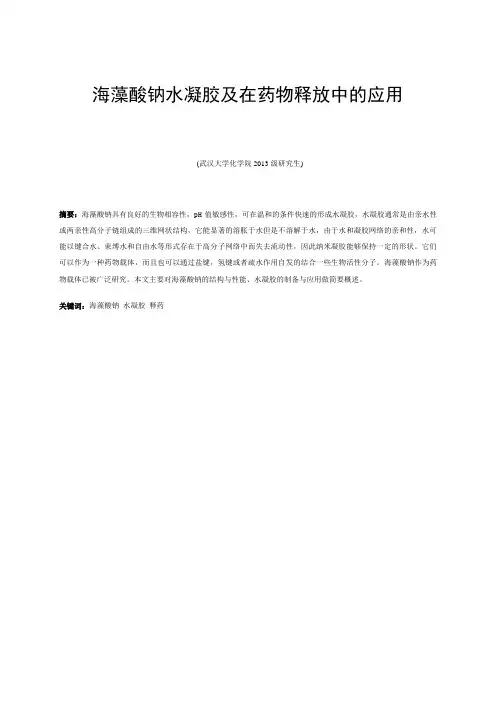
海藻酸钠水凝胶及在药物释放中的应用(武汉大学化学院2013级研究生)摘要:海藻酸钠具有良好的生物相容性,pH值敏感性,可在温和的条件快速的形成水凝胶,水凝胶通常是由亲水性或两亲性高分子链组成的三维网状结构,它能显著的溶胀于水但是不溶解于水,由于水和凝胶网络的亲和性,水可能以键合水、束缚水和自由水等形式存在于高分子网络中而失去流动性,因此纳米凝胶能够保持一定的形状。
它们可以作为一种药物载体,而且也可以通过盐键,氢键或者疏水作用自发的结合一些生物活性分子。
海藻酸钠作为药物载体已被广泛研究。
本文主要对海藻酸钠的结构与性能、水凝胶的制备与应用做简要概述。
关键词:海藻酸钠水凝胶释药0 引言高分子凝胶是由三维网络结构的高分子和溶胀介质构成,网络可以吸收介质而溶胀,介质可以是气体或者液体。
以水为溶胀介质的凝胶称为水凝胶[l]。
一般情况下,水凝胶同时具有固体和液体的性质。
比如,水凝胶具有一定的形状,并可以通过一定的方式改变其形状,具有固体的性质。
又比如,在溶胀的水凝胶中,所含有的水分子具有较大的扩散系数,这和液体的性质相类似[2]。
但是水凝胶所含有的水可以有几种存在状态,如束缚水、自由水等[3],这又与一般的液体特性不同。
同时,水凝胶还呈现出体积相转变现象,即水凝胶的体积会随着外界的温度、pH值、离子强度、光、电场强度的变化而变化[4]一般将具有这种相变的水凝胶称为智能水凝胶。
由于这些奇特的性质,水凝胶被广泛地应用于卫生、医药、食品、农业、建筑等领域。
近年来,由于智能水凝胶在药物的控制释放、基因传送、组织工程等领域的应用前景诱人,因此,科学工作者对智能水凝胶的研究十分活跃。
水凝胶根据来源不同可以分为合成类水凝胶和天然类水凝胶。
合成类水凝胶常用的单体有丙烯酸及其衍生物、丙烯酞胺及其衍生物等,合成水凝胶具有较好的稳定性,但其生物降解性和生物相容性较差。
如常用的丙烯酞胺类物质及其衍生物生物相容性较差,且不可降解,还可能会对人体产生毒副作用[5]。
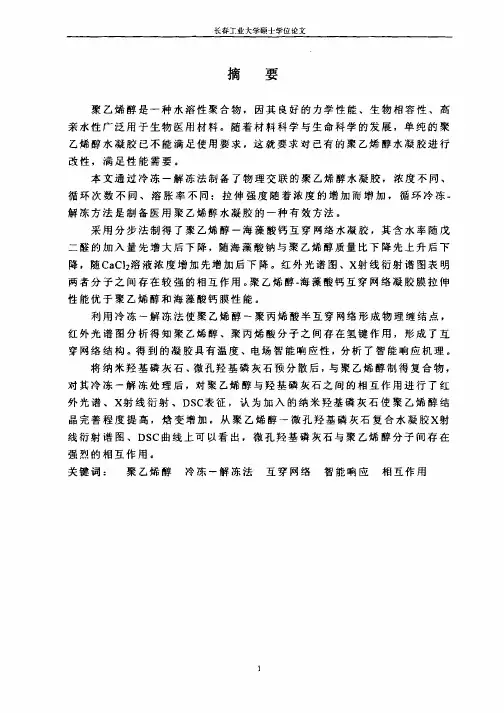
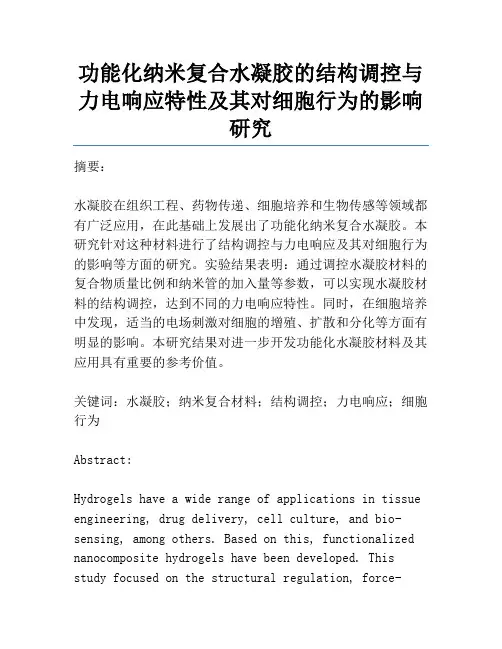
功能化纳米复合水凝胶的结构调控与力电响应特性及其对细胞行为的影响研究摘要:水凝胶在组织工程、药物传递、细胞培养和生物传感等领域都有广泛应用,在此基础上发展出了功能化纳米复合水凝胶。
本研究针对这种材料进行了结构调控与力电响应及其对细胞行为的影响等方面的研究。
实验结果表明:通过调控水凝胶材料的复合物质量比例和纳米管的加入量等参数,可以实现水凝胶材料的结构调控,达到不同的力电响应特性。
同时,在细胞培养中发现,适当的电场刺激对细胞的增殖、扩散和分化等方面有明显的影响。
本研究结果对进一步开发功能化水凝胶材料及其应用具有重要的参考价值。
关键词:水凝胶;纳米复合材料;结构调控;力电响应;细胞行为Abstract:Hydrogels have a wide range of applications in tissue engineering, drug delivery, cell culture, and bio-sensing, among others. Based on this, functionalized nanocomposite hydrogels have been developed. This study focused on the structural regulation, force-electric response, and its influence on cell behavior of such materials. The experimental results showed that, by adjusting the mass ratio of composite materials and the amount of nanotubes added, the structural regulation of hydrogel materials could be achieved to achieve different force-electric response characteristics. At the same time, during cell culture, it was found that appropriate electric fieldstimulation had a significant effect on cell proliferation, diffusion, and differentiation. The results of this study have important reference valuefor further development of functionalized hydrogel materials and their applications.Keywords: hydrogel; nanocomposite materials;structural regulation; force-electric response; cell behaviorHydrogel materials are widely used in many fields due to their good mechanical properties, high water content, and biocompatibility. However, the properties of hydrogel materials need to be further improved to meet the requirements of specific application scenarios. Structural regulation is an effective approach to modify hydrogel properties. By introducing different chemical and physical crosslinking strategies, the properties of hydrogel materials canbe finely tuned. For example, the mechanical strength and toughness of hydrogels can be improved by crosslinking them with inorganic nanoparticles, while the swelling and water absorption capacity of hydrogels can be improved by adding hydrophilic polymers.Furthermore, the force-electric response characteristics of hydrogel materials can also be regulated by adjusting the composition and structures of materials. By incorporating conductive materials, such as carbon nanotubes, graphene, and metal nanoparticles, into hydrogels, they can exhibit excellent electrical properties, such as electrical conductivity and piezoelectricity. These properties are useful for developing smart hydrogel materials that can respond to external stimuli.In addition, during cell culture, it has been found that appropriate electric field stimulation can significantly affect cell behavior. Electric fields can promote cell proliferation, migration, and differentiation, and are therefore widely used in tissue engineering and regenerative medicine. By integrating the force-electric response characteristics of hydrogel materials with cell culture techniques, it is possible to createbiomimetic microenvironments that can effectively regulate cell behavior and tissue regeneration.Overall, the development of functionalized hydrogel materials with controllable properties and force-electric response characteristics has great potential in various fields, such as biomedicine, soft robotics, and sensors. Further research in this area is required to fully realize the potential of these materialsIn the field of biomedicine, hydrogel materials are being developed for tissue engineering applications. These materials offer a scaffold for cells to grow and differentiate, allowing for the potential regeneration of damaged or diseased tissue. Hydrogels can also be used as drug delivery vehicles, providing acontrolled-release mechanism for therapeutic agents. Additionally, hydrogels with specific properties, such as conductivity or responsiveness to mechanical forces, can be used to create bioelectronic devices that can interface with biological systems.In the field of soft robotics, hydrogels offer unique advantages such as softness, high water content, and biocompatibility. They can be used as actuators, sensors, or even as computing components in soft robots. For example, hydrogels that undergo volumechanges in response to stimuli such as temperature, humidity, or light can be used as actuators to drive motion in soft robots. Hydrogels that possess mechanical or electrical sensitivity can also be used as sensors to detect changes in the environment or externally applied forces.Finally, hydrogels can be used as sensors in a variety of applications. For example, a hydrogel-based strain sensor can be used to monitor the mechanical deformation of a structure or to detect changes in pressure or temperature. Additionally, hydrogels that are sensitive to specific biological molecules, such as glucose or DNA, can be used to create biosensorsfor medical or environmental monitoring applications.In conclusion, the development of functionalized hydrogel materials with controllable properties and force-electric response characteristics has great potential in various fields, such as biomedicine, soft robotics, and sensors. While significant progress has been made in these areas, further research is required to fully realize the potential of these materials. The continued development of new hydrogel materials and the exploration of their novel applications is an exciting area of research with significant potential impactIn the field of biomedicine, personalized hydrogel materials hold great promise. Scientists are exploring the use of these materials to create custom tissue scaffolds that can aid in the regeneration of damaged or diseased tissues. Hydrogels can also be used for drug delivery, as they can be modified to release drugs in a controlled manner. Further research in this area could lead to the development of highly effective treatments for various illnesses and injuries.Another area where personalized hydrogel materials could have an impact is soft robotics. Robotic structures made from hydrogels can be designed to mimic the movement and flexibility of biological organisms, making them useful for a variety of applications. Hydrogels can also be modified to respond to electrical stimuli, making them ideal for use in robotic sensors.In addition, hydrogels can also be used as sensors themselves. By embedding sensors into the hydrogel matrix, scientists can create materials that are highly sensitive to changes in temperature, pressure, or other environmental factors. This makes them useful in a wide range of applications, from environmental monitoring to medical diagnostics.Despite the great potential of personalized hydrogel materials, there are still some challenges that need to be overcome. Perhaps the biggest challenge is developing hydrogels that can withstand the harsh conditions of the human body. Currently, many hydrogels break down quickly or trigger an immune response when implanted in the body, which limitstheir usefulness.Another challenge is developing hydrogels that can be easily synthesized and modified. Many current hydrogel materials are made using complex processes that are difficult to replicate, which can make them prohibitively expensive for many applications.Despite these challenges, personalized hydrogel materials remain a promising area of research with the potential to revolutionize fields ranging from biomedicine to robotics. With continued research and development, these materials could be the key to unlocking a world of new possibilitiesIn conclusion, personalized hydrogel materials have the potential to transform various fields such as biomedicine, robotics, and more. The ability to tailor the physical properties of hydrogels to specific applications can lead to the development of innovativeand effective solutions. However, challenges related to scalability and cost-effectiveness must be addressed for these materials to become widely accessible. Further research and development in this area can unlock exciting new possibilities for the future。
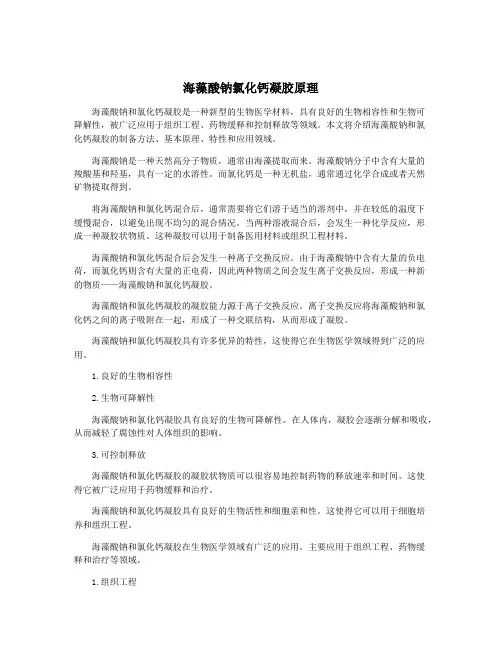
海藻酸钠氯化钙凝胶原理海藻酸钠和氯化钙凝胶是一种新型的生物医学材料,具有良好的生物相容性和生物可降解性,被广泛应用于组织工程、药物缓释和控制释放等领域。
本文将介绍海藻酸钠和氯化钙凝胶的制备方法、基本原理、特性和应用领域。
海藻酸钠是一种天然高分子物质,通常由海藻提取而来。
海藻酸钠分子中含有大量的羧酸基和羟基,具有一定的水溶性。
而氯化钙是一种无机盐,通常通过化学合成或者天然矿物提取得到。
将海藻酸钠和氯化钙混合后,通常需要将它们溶于适当的溶剂中,并在较低的温度下缓慢混合,以避免出现不均匀的混合情况。
当两种溶液混合后,会发生一种化学反应,形成一种凝胶状物质。
这种凝胶可以用于制备医用材料或组织工程材料。
海藻酸钠和氯化钙混合后会发生一种离子交换反应。
由于海藻酸钠中含有大量的负电荷,而氯化钙则含有大量的正电荷,因此两种物质之间会发生离子交换反应,形成一种新的物质——海藻酸钠和氯化钙凝胶。
海藻酸钠和氯化钙凝胶的凝胶能力源于离子交换反应。
离子交换反应将海藻酸钠和氯化钙之间的离子吸附在一起,形成了一种交联结构,从而形成了凝胶。
海藻酸钠和氯化钙凝胶具有许多优异的特性,这使得它在生物医学领域得到广泛的应用。
1.良好的生物相容性2.生物可降解性海藻酸钠和氯化钙凝胶具有良好的生物可降解性。
在人体内,凝胶会逐渐分解和吸收,从而减轻了腐蚀性对人体组织的影响。
3.可控制释放海藻酸钠和氯化钙凝胶的凝胶状物质可以很容易地控制药物的释放速率和时间。
这使得它被广泛应用于药物缓释和治疗。
海藻酸钠和氯化钙凝胶具有良好的生物活性和细胞亲和性。
这使得它可以用于细胞培养和组织工程。
海藻酸钠和氯化钙凝胶在生物医学领域有广泛的应用。
主要应用于组织工程、药物缓释和治疗等领域。
1.组织工程海藻酸钠和氯化钙凝胶可以被用于组织工程。
在组织工程中,凝胶可以用于承载细胞和生长因子,从而促进组织的修复和再生。
2.药物缓释3..治疗海藻酸钠和氯化钙凝胶可以被用于治疗伤口、骨折和其他外科手术等疾病。
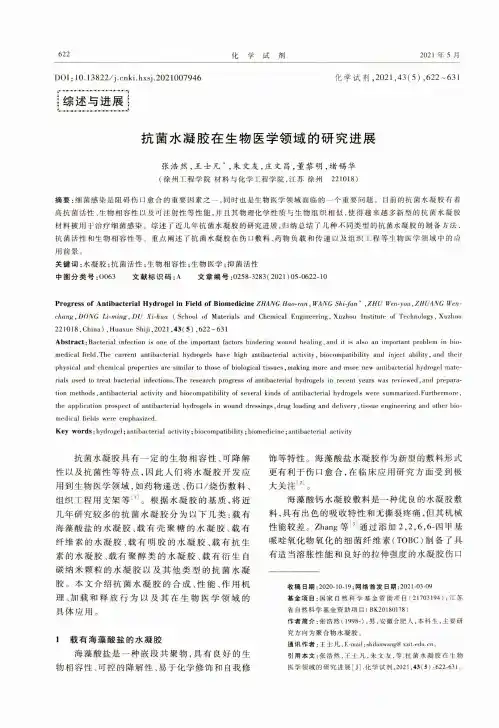
622化学试剂2021年5月DOI:10.13822/ki.hxsj.2021007946综述与进展化学试剂,2021,43(5) ,622〜631抗菌水凝胶在生物医学领域的研究进展张浩然,王士凡'朱文友,庄文昌,董黎明,堵锡华(徐州工程学院材料与化学工程学院,江苏徐州221018)摘要:细菌感染是阻碍伤口愈合的重要因素之一,同时也是生物医学领域面临的一个重要问题。
目前的抗菌水凝胶有着高抗菌活性、生物相容性以及可注射性等性能,并且其物理化学性质与生物组织相似,使得越来越多新型的抗菌水凝胶材料被用于治疗细菌感染。
综述了近几年抗菌水凝胶的研究进展,归纳总结了几种不同类型的抗菌水凝胶的制备方法,抗菌活性和生物相容性等。
重点阐述了抗菌水凝胶在伤口敷料、药物负载和传递以及组织工程等生物医学领域中的应用前景。
关键词:水凝胶;抗菌活性;生物相容性;生物医学;抑菌活性中图分类号:0063 文献标识码:A 文章编号:0258-3283( 2021 ) 05-0622-10P ro g re ss of A n tib ac terial H yd ro gel in Field of B iom edicine ZHANG Hao-ran ,WANG Shi-fan* yZHU Wen-you ,ZHUANG Wen-change DONG L i-m in g, DU Xi-hua( School of Materials and Chemical Engineering, Xuzhou Institute of Technology, Xuzhou 221018,China) ,Huaxue Shiji,2021 ,43(5),622-631A b stra c t: Bacterial infection is one of the important factors hindering wound healing, and it is also an important problem in biomedical field.The current antibacterial hydrogels have high antibacterial activity, biocompatibility and inject ability, and their physical and chemical properties are similar to those of biological tissues, making more and more new antibacterial hydrogel materials used to treat bacterial infections.The research progress of antibacterial hydrogels in recent years was reviewed,and preparation methods,antibacterial activity and biocompatibility of several kinds of antibacterial hydrogels were summarized.Furthermore, the application prospect of antibacterial hydrogels in wound dressings, drug loading and delivery, tissue engineering and other biomedical fields were emphasized.Key w ords: hydrogel ; antibacterial activity ; biocompatibility ; biomedicine; antibacterial activity抗菌水凝胶具有一定的生物相容性、可降解 性以及抗菌性等特点,因此人们将水凝胶开发应用到生物医学领域,如药物递送、伤口 /烧伤敷料、组织工程用支架等[|]。
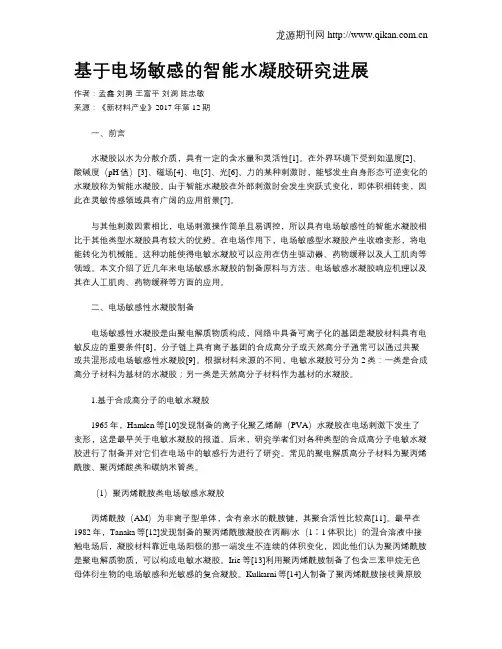
基于电场敏感的智能水凝胶研究进展作者:孟鑫刘勇王富平刘澜陈忠敏来源:《新材料产业》2017年第12期一、前言水凝胶以水为分散介质,具有一定的含水量和灵活性[1]。
在外界环境下受到如温度[2]、酸碱度(pH值)[3]、磁场[4]、电[5]、光[6]、力的某种刺激时,能够发生自身形态可逆变化的水凝胶称为智能水凝胶。
由于智能水凝胶在外部刺激时会发生突跃式变化,即体积相转变,因此在灵敏传感领域具有广阔的应用前景[7]。
与其他刺激因素相比,电场刺激操作简单且易调控,所以具有电场敏感性的智能水凝胶相比于其他类型水凝胶具有较大的优势。
在电场作用下,电场敏感型水凝胶产生收缩变形,将电能转化为机械能。
这种功能使得电敏水凝胶可以应用在仿生驱动器、药物缓释以及人工肌肉等领域。
本文介绍了近几年来电场敏感水凝胶的制备原料与方法、电场敏感水凝胶响应机理以及其在人工肌肉、药物缓释等方面的应用。
二、电场敏感性水凝胶制备电场敏感性水凝胶是由聚电解质物质构成,网络中具备可离子化的基团是凝胶材料具有电敏反应的重要条件[8],分子链上具有离子基团的合成高分子或天然高分子通常可以通过共聚或共混形成电场敏感性水凝胶[9]。
根据材料来源的不同,电敏水凝胶可分为2类:一类是合成高分子材料为基材的水凝胶;另一类是天然高分子材料作为基材的水凝胶。
1.基于合成高分子的电敏水凝胶1965年,Hamlen等[10]发现制备的离子化聚乙烯醇(PVA)水凝胶在电场刺激下发生了变形,这是最早关于电敏水凝胶的报道。
后来,研究学者们对各种类型的合成高分子电敏水凝胶进行了制备并对它们在电场中的敏感行为进行了研究。
常见的聚电解质高分子材料为聚丙烯酰胺、聚丙烯酸类和碳纳米管类。
(1)聚丙烯酰胺类电场敏感水凝胶丙烯酰胺(AM)为非离子型单体,含有亲水的酰胺键,其聚合活性比较高[11]。
最早在1982年,Tanaka等[12]发现制备的聚丙烯酰胺凝胶在丙酮/水(1∶1体积比)的混合溶液中接触电场后,凝胶材料靠近电场阳极的那一端发生不连续的体积变化,因此他们认为聚丙烯酰胺是聚电解质物质,可以构成电敏水凝胶。

海藻酸钠水凝胶及在药物释放中的应用(武汉大学化学院2013级研究生)摘要:海藻酸钠具有良好的生物相容性,pH值敏感性,可在温和的条件快速的形成水凝胶,水凝胶通常是由亲水性或两亲性高分子链组成的三维网状结构,它能显著的溶胀于水但是不溶解于水,由于水和凝胶网络的亲和性,水可能以键合水、束缚水和自由水等形式存在于高分子网络中而失去流动性,因此纳米凝胶能够保持一定的形状。
它们可以作为一种药物载体,而且也可以通过盐键,氢键或者疏水作用自发的结合一些生物活性分子。
海藻酸钠作为药物载体已被广泛研究。
本文主要对海藻酸钠的结构与性能、水凝胶的制备与应用做简要概述。
关键词:海藻酸钠水凝胶释药0 引言高分子凝胶是由三维网络结构的高分子和溶胀介质构成,网络可以吸收介质而溶胀,介质可以是气体或者液体。
以水为溶胀介质的凝胶称为水凝胶[l]。
一般情况下,水凝胶同时具有固体和液体的性质。
比如,水凝胶具有一定的形状,并可以通过一定的方式改变其形状,具有固体的性质。
又比如,在溶胀的水凝胶中,所含有的水分子具有较大的扩散系数,这和液体的性质相类似[2]。
但是水凝胶所含有的水可以有几种存在状态,如束缚水、自由水等[3],这又与一般的液体特性不同。
同时,水凝胶还呈现出体积相转变现象,即水凝胶的体积会随着外界的温度、pH值、离子强度、光、电场强度的变化而变化[4]一般将具有这种相变的水凝胶称为智能水凝胶。
由于这些奇特的性质,水凝胶被广泛地应用于卫生、医药、食品、农业、建筑等领域。
近年来,由于智能水凝胶在药物的控制释放、基因传送、组织工程等领域的应用前景诱人,因此,科学工作者对智能水凝胶的研究十分活跃。
水凝胶根据来源不同可以分为合成类水凝胶和天然类水凝胶。
合成类水凝胶常用的单体有丙烯酸及其衍生物、丙烯酞胺及其衍生物等,合成水凝胶具有较好的稳定性,但其生物降解性和生物相容性较差。
如常用的丙烯酞胺类物质及其衍生物生物相容性较差,且不可降解,还可能会对人体产生毒副作用[5]。
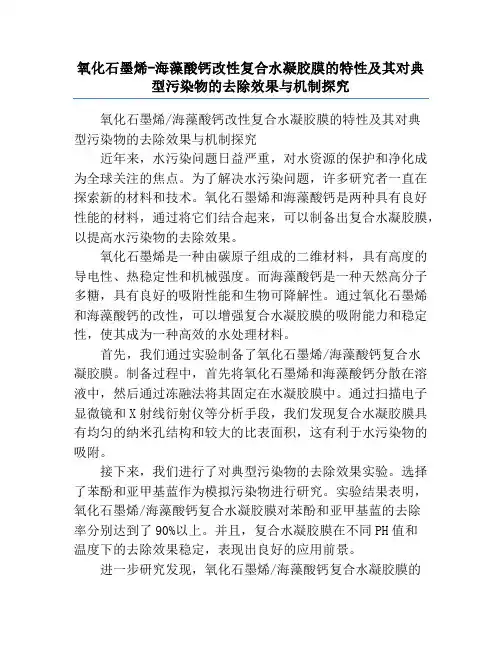
氧化石墨烯-海藻酸钙改性复合水凝胶膜的特性及其对典型污染物的去除效果与机制探究氧化石墨烯/海藻酸钙改性复合水凝胶膜的特性及其对典型污染物的去除效果与机制探究近年来,水污染问题日益严重,对水资源的保护和净化成为全球关注的焦点。
为了解决水污染问题,许多研究者一直在探索新的材料和技术。
氧化石墨烯和海藻酸钙是两种具有良好性能的材料,通过将它们结合起来,可以制备出复合水凝胶膜,以提高水污染物的去除效果。
氧化石墨烯是一种由碳原子组成的二维材料,具有高度的导电性、热稳定性和机械强度。
而海藻酸钙是一种天然高分子多糖,具有良好的吸附性能和生物可降解性。
通过氧化石墨烯和海藻酸钙的改性,可以增强复合水凝胶膜的吸附能力和稳定性,使其成为一种高效的水处理材料。
首先,我们通过实验制备了氧化石墨烯/海藻酸钙复合水凝胶膜。
制备过程中,首先将氧化石墨烯和海藻酸钙分散在溶液中,然后通过冻融法将其固定在水凝胶膜中。
通过扫描电子显微镜和X射线衍射仪等分析手段,我们发现复合水凝胶膜具有均匀的纳米孔结构和较大的比表面积,这有利于水污染物的吸附。
接下来,我们进行了对典型污染物的去除效果实验。
选择了苯酚和亚甲基蓝作为模拟污染物进行研究。
实验结果表明,氧化石墨烯/海藻酸钙复合水凝胶膜对苯酚和亚甲基蓝的去除率分别达到了90%以上。
并且,复合水凝胶膜在不同PH值和温度下的去除效果稳定,表现出良好的应用前景。
进一步研究发现,氧化石墨烯/海藻酸钙复合水凝胶膜的去除机制主要包括物理吸附和化学吸附两种。
物理吸附是通过孔隙结构和表面电荷吸附污染物,而化学吸附是通过氧化石墨烯和海藻酸钙的官能团与污染物之间的化学反应实现的。
这两种吸附机制的协同作用使得复合水凝胶膜的去除效果更为显著。
综上所述,氧化石墨烯/海藻酸钙复合水凝胶膜具有优异的吸附性能和稳定性,适用于水污染物的去除。
通过对典型污染物的实验研究,我们发现复合水凝胶膜对苯酚和亚甲基蓝的去除效率较高。
同时,我们也揭示了复合水凝胶膜的吸附机制,为进一步提高水净化技术的研发提供了理论依据。

海藻酸钠水凝胶的制备及其在药物释放中的应用一、本文概述本文旨在深入探讨海藻酸钠水凝胶的制备方法及其在药物释放领域的应用。
海藻酸钠作为一种天然高分子材料,具有良好的生物相容性和生物降解性,因此在医药领域具有广泛的应用前景。
本文首先将对海藻酸钠水凝胶的制备过程进行详细的介绍,包括材料选择、反应条件优化等关键步骤。
随后,我们将重点关注海藻酸钠水凝胶在药物释放方面的应用,探讨其作为药物载体的优势和潜力。
本文还将对海藻酸钠水凝胶在药物释放过程中的性能进行评估,包括药物释放速率、释放量以及药物释放机制等。
我们将对海藻酸钠水凝胶在药物释放领域的应用前景进行展望,以期为其在医药领域的进一步应用提供理论支持和实践指导。
二、海藻酸钠水凝胶的制备海藻酸钠水凝胶的制备过程相对简单,主要涉及到海藻酸钠与钙离子的交联反应。
将海藻酸钠溶解在适当的溶剂(如去离子水)中,通过加热和搅拌的方式确保海藻酸钠充分溶解,形成均一的海藻酸钠溶液。
然后,将含有钙离子的溶液(如氯化钙溶液)作为交联剂,以一定的速度滴加到海藻酸钠溶液中。
在滴加过程中,钙离子与海藻酸钠中的羧酸根离子发生离子交换,形成稳定的海藻酸钙凝胶。
为确保水凝胶的均匀性和稳定性,滴加过程需要控制速度和搅拌速率。
海藻酸钠的浓度、钙离子的浓度以及反应温度等因素都会影响水凝胶的形成和性能。
因此,在制备过程中,需要对这些参数进行优化,以获得具有理想性能的海藻酸钠水凝胶。
制备完成后,可通过一系列表征手段,如扫描电子显微镜(SEM)、傅里叶变换红外光谱(FTIR)等,对海藻酸钠水凝胶的微观结构和化学性质进行分析。
这些表征结果可以为后续的药物释放研究提供基础数据。
通过合理的制备工艺和参数优化,可以制备出性能稳定的海藻酸钠水凝胶,为药物释放等应用领域提供有力支持。
三、海藻酸钠水凝胶在药物释放中的应用海藻酸钠水凝胶作为一种理想的药物载体,在药物释放领域具有广泛的应用前景。
其独特的三维网络结构和良好的生物相容性,使得海藻酸钠水凝胶能够有效地控制药物的释放速率和释放量,从而实现对药物释放的精确调控。
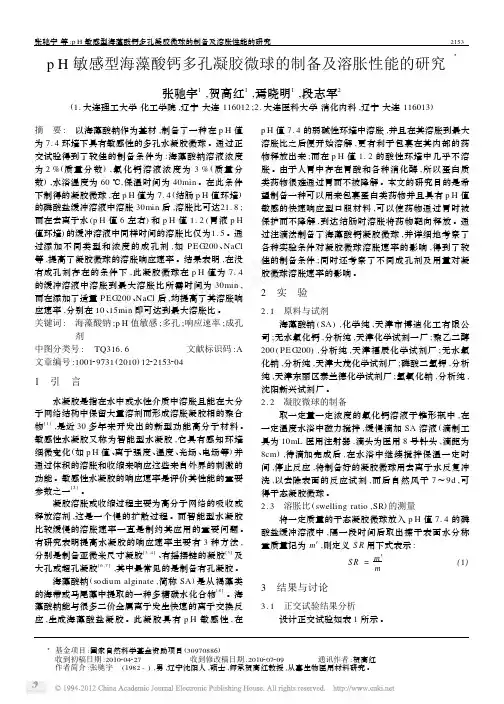
智能高分子及水凝胶的响应性及其应用一、本文概述随着科技的飞速发展,智能高分子及水凝胶的响应性及其应用已经引起了全球科研人员的广泛关注。
智能高分子,作为一类具有特殊响应性能的高分子材料,能够在外部刺激下发生可逆或不可逆的物理或化学变化,从而展现出独特的性质和功能。
水凝胶,作为一种特殊的智能高分子,能够在水溶液中吸收并保持大量水分,同时保持其三维网络结构。
智能高分子及水凝胶的响应性使得它们在许多领域,如药物传递、生物传感器、组织工程、环境治理等,具有广泛的应用前景。
本文旨在全面介绍智能高分子及水凝胶的响应性及其应用。
我们将对智能高分子及水凝胶的基本概念、分类和性质进行阐述,以便读者对它们有一个清晰的认识。
接着,我们将深入探讨智能高分子及水凝胶的响应机制,包括温度响应、pH响应、光响应、电响应等,以及这些响应机制在实际应用中的优势与挑战。
我们将详细介绍智能高分子及水凝胶在药物传递、生物传感器、组织工程、环境治理等领域的应用案例,展望其未来的发展趋势。
通过本文的阅读,我们期望读者能够对智能高分子及水凝胶的响应性及其应用有一个全面而深入的了解,同时也为相关领域的科研人员提供有益的参考和启示。
二、智能高分子的响应性智能高分子,作为一种新型的功能高分子材料,其最显著的特征在于其独特的响应性。
这种响应性源自高分子链上的特定官能团或结构,使其能在外界环境刺激下发生物理或化学性质的变化。
这些刺激源广泛而多样,包括温度、pH值、光照、电场、磁场以及化学物质等。
温度响应性高分子是最常见的智能高分子之一。
这类高分子通常含有温敏性基团,如聚(N-异丙基丙烯酰胺)(PNIPAM),其在低于最低临界溶解温度(LCST)时呈现亲水性,而在高于LCST时则转变为疏水性。
这种温敏性质使得这类高分子在药物控释、生物传感器和智能纺织品等领域具有广泛的应用。
pH响应性高分子则能在不同pH值环境下发生性质变化。
这些高分子通常含有可电离的基团,如羧基、氨基等,其电离状态随pH值的变化而变化,从而改变高分子的溶解性、电荷状态和亲疏水性。
壳聚糖-海藻酸钙微球荧光标记反应对微球膜强度影响的研究范妮;薛伟明【摘要】以壳聚糖-海藻酸钙载药微球给药后的体内检测为研究背景,探讨不同反应条件下壳聚糖-海藻酸钙微球荧光标记反应对微球膜在模拟体液中的强度影响.以壳聚糖、海藻酸钠为微球制备载体材料,以异硫氰酸酯(FITC)为荧光标记物对微球进行荧光标记.采用标记了FITC的微球在模拟体液中的膨胀率来表征微球膜的相对强度.采用相对分子质量为50 000、脱乙酰度85%、荧光标记浓度0.01 g/mL的壳聚糖,成膜液浓度0.015 g/mL,成膜时间30 min制备出的荧光微球在模拟胃、肠液中表现出良好的膜强度及稳定性.为研究壳聚糖-海藻酸钙载药微球在体内的分布、吸收、降解特性提供了适宜的入体实验条件.%This paper investigates the impact of fluorescence labeling reaction of chitosan-caleium alginate microsphere for labeling on microphere membrane strength in simulated body hquid under different conditions in order to detect such microspheres invivo.With chitosan and sodium alginate as materials for preparing microsphere and with isothioeyanate FITC as fluorescence label for labeling microspheres, the rate of expansion of FITC-labeled chitosan-alginate microspheres is determined to characterize microsphere membrane strength.The FITC-labeled microspheres are prepared with the FITC-labeled chitosan of which concentration is O.015 g/mL reacting 30 rain with calcium alginate microspheres.On the other hand, chitosan molecular weight is 50 000, the degree of deacytylation is 85%and the solution concentration is O.01 g/mL.Such FITC-labeled microspheres show better membrane strength and stability.The appropriate experimentalconditions are provided to study the distribution,absorbency and biodegradation characteristics of drug-loaded chitosan-alginate microspbere in vivo.【期刊名称】《四川师范大学学报(自然科学版)》【年(卷),期】2011(034)002【总页数】5页(P231-235)【关键词】壳聚糖;海藻酸钙;微球;荧光标记;膜强度【作者】范妮;薛伟明【作者单位】陕西教育学院,化学与化工系,陕西,西安710100;西北大学,化工学院,陕西,西安,710069【正文语种】中文【中图分类】TQ460.6采用生物相容性好及可控降解性的壳聚糖、海藻酸钠作为载药微球材料应用于多肽蛋白质的口服给药具有独特的优越性,近年已引起了相当的重视[1-4].为了研究壳聚糖/海藻酸盐微球在体内的转运、吸收与分布状况,本文采用荧光素异硫氰酸酯(FITC)对壳聚糖/海藻酸盐微球进行荧光标记,期望通过检测荧光素达到对微球在体内的准确定位及定量.但壳聚糖的2-NH2既要与FITC反应,又要参与海藻酸钙凝胶珠的成膜反应,这势必会对微球成膜量造成一定程度的影响,而成膜量对微球膜强度具有重要影响作用.微球膜的强度对于包埋在其中的蛋白质药物来说至关重要.如果微球膜在体内意外破裂会导致包埋药物的突释,从而导致人体的一系列不良药物反应,甚至出现生命危险,所以必须对标记了FITC的微球膜的强度进行系统的考察.本文采用被标记了荧光素的微球(荧光微球)在模拟胃、肠液中膨胀率的方法表征荧光微球膜的强度.标记了FITC的壳聚糖/海藻酸钙微球是以海藻酸钙凝胶珠为基础的,而海藻酸钙属于水凝胶类物质,并且微球是具有多孔网络结构的球体.在模拟体液中,一方面微球膜上的电荷受到静电力作用,微球发生收缩或膨胀;另一方面微球膜对凝胶珠发生的形变行为将产生抑制作用.当这一对力相等时,微球体积达到平衡.微球膜强度越高,其体积越不容易发生变化.通过考察相关因素对荧光微球膜强度的影响,探索出适宜入体实验的壳聚糖/海藻酸钙荧光微球制备条件.1.1 试剂与材料荧光素异硫氰酸酯(FITC)(色谱纯,Sigma公司);壳聚糖(医用级,浙江金壳生物化学有限公司);海藻酸钠(化学纯,西安化学试剂采购站);冰醋酸(分析纯,天津市瑞金特化学品有限公司);无水氯化钙(分析纯,天津市科密欧化学试剂开发中心);浓盐酸(分析纯,西安市化学试剂厂);氢氧化钠(分析纯,广东西陇化工厂);磷酸二氢钾(分析纯,天津市科密欧化学试剂开发中心);其余试剂均为国产分析纯. 1.2 仪器脉冲电场液滴制备仪(自制);WZ-50C2微量注射泵(浙江大学医学仪器有限公司);UV-2501紫外-可见分光光度计(日本岛津);XDS-1B倒置显微镜(重庆光电仪器有限公司);FA2004电子天平(上海精密科学仪器公司);HJ-3数显恒温磁力搅拌器(常州国华电器公司);CHA-S气浴恒温振荡器(江苏金坛宏华仪器厂);LD4-2低速离心机(北京医用离心机厂);DZF-6020型真空干燥箱(上海精宏实验设备有限公司).1.3 实验方法1.3.1 模拟胃液、模拟肠液配制[5]模拟胃液为pH值1.2的盐酸溶液.准确移取9.0 mL浓HCl于适量蒸馏水中,转移至1 000 mL容量瓶中加水稀释至刻度;模拟肠液为pH值7.4的磷酸盐缓冲溶液.准确称取 1.600 g NaOH、6.800 g KH2PO4,用适量蒸馏水中溶解,转移至1 000 mL容量瓶定容.1.3.2 成膜液的制备体积分数2%醋酸为溶剂,将质量分数10%的NaOH调至pH 值10,配制0.01 g/mL的壳聚糖溶液,移取一定量上述壳聚糖溶液,在30℃、150 r/min下,于恒温振荡培养箱中振摇30 min.以V(chi溶液)∶V(FITC溶液)=5∶1的比例加入质量浓度为45.5 μg/mL FITC磷酸盐缓冲溶液(磷酸盐缓冲液简称PBS,pH值7.4),在相同条件下避光反应5 h后,在3 000 r/min下离心10 min,收集被标记上FITC的壳聚糖沉淀,用PBS溶液反复洗涤沉淀至上清在492 nm下无吸收.真空干燥荧光壳聚糖14 h,以体积分数2%醋酸为溶剂配制质量浓度0.015 g/mL荧光壳聚糖成膜液备用.1.3.3 海藻酸钙凝胶珠的制备方法[6]制备条件:凝胶浴为0.01 g/mL CaCl2溶液;高压脉冲电场发生器强度电压380 V;脉冲频率0.796 Hz;触发时间1 ms;注射泵速为25 mL/h;液面距为20 mm.将盛有20 mL 0.01 g/mL海藻酸钠的注射器固定于微量注射泵上,高压脉冲电场发生器正极与注射器金属锐孔(孔径450 μm)连接;负极与凝胶浴中的导电环连接,锐孔与凝胶浴间形成高压脉冲静电场.在微量注射泵推动力及电场力作用下海藻酸钠从锐孔滴入80 mL凝胶浴中形成海藻酸钙凝胶珠,反应完毕后固化10 min备用.1.3.4 荧光微球的制备将0.3 g海藻酸钙胶珠置于试管中,加入1.3.2中以体积分数2%醋酸配制的0.015 g/mL FITC 标记壳聚糖溶液2.0 mL,充分将凝胶珠处于悬浮状态成膜反应30 min.反应完毕后,PBS溶液反复洗涤荧光微球至上清在492 nm无吸收.1.3.5 模拟胃、肠液中荧光微球膜强度实验采用1.3.4的方法制备荧光微球.倒置显微镜下随机读取50个微球的粒径,求其平均值,定义为D0.然后加入10 mL模拟胃液.在1~3 h时,随机读取50个微球的粒径,求粒径平均值.不同时间点下读取的粒径平均值定义为Dt.同样方法制备、洗涤荧光微球,倒置显微镜下随机读取50个微球的粒径,其平均值定义为D0.加入10 mL模拟肠液,在1、3和5 h时,同样随机读取50个微球的粒径求粒径平均值Dt.将不同时间点读取的平均粒径与初始荧光微球的粒径进行比较,求出荧光微球的膨胀率,计算公式为Sw=Dt/D0.2.1 空白微球与荧光微球在模拟胃、肠液中膜强度对比实验分别用壳聚糖、荧光壳聚糖配制浓度为0.015 g/mL的成膜液制备空白微球及荧光微球.制备的微球照1.3.5方法开展膜强度实验.微球膨胀率随时间的变化如图1和图2所示.结果表明,两种类型的微球在模拟胃液中都有一定程度的皱缩现象,即随着时间的延长粒径逐渐减小.但是在模拟肠液中则出现了相反的情况,微球在5 h的时间范围内逐渐膨胀变大.由制备微球的方法可知:不管是空白微球还是荧光微球在其表面及内部都存在一定数量未发生成膜反应的5-COO-,即微球是带负电荷的.在酸性介质中,大量存在的H+与COO-正负电荷相互抵消,削弱微球上的负电荷数,微球分子内部的相互斥力随之减小,所以随着时间的增加微球皱缩、粒径变小.当皱缩作用产生的收缩力与微球膜抑制这种形变产生的作用力达到平衡时,微球粒径不再发生变化.模拟肠液是碱性环境,其中存在着大量的OH-,这使得微球中分子斥力加强,同时模拟肠液逐渐通过微球的多孔网络结构渗透到微球中去,这样微球的体积逐渐增大,膨胀率随时间的变化如图2所示.从图中可以看出微球在模拟肠液中1 h后,其膨胀率趋于平缓.空白微球在1、3和5 h的膨胀率分别为1.58、1.63 和 1.64;而荧光微球分别为 1.67、1.67和1.69.因此1 h后,膨胀力与微球膜产生的抑制力基本处于平衡状态.根据图1和图2,空白微球在模拟胃、肠液中相较荧光微球而言,其微球粒径随时间变化幅度较小.即在模拟胃液中空白微球膨胀率较大;模拟肠液中则反之.壳聚糖中的2-NH2即要与FITC反应,又要参与海藻酸钙凝胶珠的成膜反应.因此标记了FITC的壳聚糖进行成膜反应时,制备的荧光微球较空白微球成膜量少.成膜量多的微球膜强度较高.膜强度高的微球不易受外界作用力的干扰,所以空白微球相较而言粒径变化较小.采用FITC标记壳聚糖-海藻酸钙微球在一定程度上将降低微球膜的强度,因此有必要开展微球荧光标记反应对微球膜影响的相关工作.2.2 壳聚糖分子量对荧光微球在模拟胃、肠液中膜强度的影响相对分子质量为5、10、20和30万的壳聚糖对荧光微球在模拟胃、肠液中膨胀率的影响如图3和图4所示.结果表明,图3中分子量增加膨胀率逐渐减小,即微球膜强度逐渐降低.图4中分子量增加膨胀率逐渐增加,说明微球膜强度降低;同时发现荧光微球与口服相关介质接触1h后,微球体积基本保持不变.文献[7]中指出低分子量的壳聚糖有利于制备高强度膜的微球,所以随着分子量的增加荧光微球膜的强度降低.由图3和图4可知,采用相对分子质量为50 000的壳聚糖将制备出膜强度较高的荧光微球.2.3 壳聚糖溶液浓度对荧光微球在模拟胃、肠液中膜强度的影响采用质量浓度为0.005、0.01、0.013和0.015 g/mL 的壳聚糖溶液制备0.015 g/mL荧光壳聚糖,将其与海藻酸钙凝胶珠进行成膜反应.图5和图6表明,质量浓度为0.01 g/mL的壳聚糖制得的荧光微球在模拟胃液中有最大的膨胀率,模拟肠液中有最小的膨胀率.此微球在模拟体液中具有较高的微球膜强度.2.4 壳聚糖脱乙酰度对荧光微球在模拟胃、肠液中膜强度的影响分别采用脱乙酰度为85%、90%和95%的壳聚糖制备荧光微球.图7和图8表明,随着壳聚糖脱乙酰度的增大,荧光微球膜强度降低,粒径在外力作用下更容易改变.由于壳聚糖脱乙酰度与壳聚糖荧光标记正向相关.随着壳聚糖脱乙酰度增大,结合到壳聚糖上的FITC增多,酸性条件下参加成膜反应的数量减少,引起最终成膜量减少,微球膜强度降低.因此壳聚糖脱乙酰度与荧光微球膜强度负性相关.2.5 成膜液浓度对荧光微球在模拟胃、肠液中膜强度的影响成膜液浓度小,荧光壳聚糖主要在海藻酸钙表面成膜.成膜液浓度越大,荧光壳聚糖不仅可以在表面进行成膜反应,进入海藻酸钙凝胶珠多孔网络结构内的机率也随之增大,成膜量相较增多,荧光微球膜强度随之提高.因此图9和图10表明,荧光壳聚糖成膜液浓度与荧光微球膜在模拟体液中的强度成正向相关.2.6 成膜时间对荧光微球在模拟胃、肠液中膜强度的影响图11和图12表明,随着成膜时间的增加,荧光微球膜强度变大.成膜反应时间增加,更多的荧光壳聚糖进入海藻酸钙凝胶珠多孔网络结构,并与其发生成膜反应,微球成膜量增多,膜厚度随之增加.所以增加成膜反应时间有利于提高荧光微球膜强度.1)壳聚糖分子的2-NH2即能与FITC共价结合,又参与海藻酸钙凝胶珠的成膜反应,因此壳聚糖的荧光标记程度对荧光微球膜的成膜量具有重要影响作用,进而影响荧光微球膜在模拟胃、肠液中的强度及稳定.2)模拟胃液中,荧光微球随时间增加发生皱缩现象;模拟肠液中,荧光微球随时间延长出现膨胀现象;且荧光微球与口服相关介质接触1h后,其膨胀率基本趋于稳定状态.3)本文研究表明:采用相对分子质量为50 000、脱乙酰度85%、壳聚糖溶液浓度0.01 g/mL,成膜液质量浓度0.015 g/mL,成膜时间30 min制备出的荧光微球在模拟胃、肠液中表现出良好的膜强度及球形度.【相关文献】[1]Borges O,Silva M,Sousa A D,et al.Alginate coated chitosan nanoparticles are an effective subcutaneous adjuvant for hepatitis B surface antigen[J].International Immunopharmacology,2008,8(13/14):1773-1780.[2]Hamidi M,Azadi A,Rafiei P.Hydrogel nanoparticles in drug delivery[J].Advanced Drug Delivery Reviews,2008,60(15):1638-1649.[3]George M,Abraham T E.pH sensitive alginate-guar gum hydrogel for the controlled delivery of protein drugs[J].International J Pharmaceutics,2007,335(1/2):123-129.[4]Yuan Y,Chesnutt B M,Utturkar G,et al.The effect of cross-linking of chitosan microspheres with genipin on protein release[J].Carbohydrate Polymers,2007,68(3/5):561-567.[5]国家药典委员会.中华人民共和国药典(第一部)[S].北京:化学工业出版社,2005.[6]黄可可.蛋白质药物的海藻酸钙/壳聚糖微球控释载体制备及性能研究[D].西安:西北大学,2006.[7]刘群.新型生化药用微胶囊的研究[D].大连:中国科学院大连化学物理研究所,2000.。
海藻酸钙凝胶微球的制备和pH敏感释放刘丽英;王圣洁【期刊名称】《中国组织工程研究》【年(卷),期】2009(013)042【摘要】背景:大多数蛋白质和多肽药物存在稳定性差、生物利用度低等缺点,为提高其生物利用度,目前常用将蛋白类药物包裹在高分子材料中,制成缓释控释体系.由于蛋白质外层的载体材料能起到一定保护作用,因此可增加此类药物的稳定性.目的:以含水率为指标,通过正交实验设计,找出制备海藻酸钙微球的最佳条件.并以牛血清白蛋白为模型药物,考察微球载药性能及DH环境下的释放规律.设计、时间及地点:对比观察实验,于2007-10/2009-05在四川大学高分子科学与工程实验楼完成.材料:海藻酸钠、无水氯化钙由成都科龙试剂公司提供,牛血清白蛋白由上海伯奥生物科技有限公司提供.方法:采用滴制法制备了海藻酸钙微球,考察了海藻酸钠质量分数、氯化钙质量分数、交联时间对微球含水率的影响.采用牛血清白蛋白作为模型药物,对优化条件下海藻酸钠凝胶微球进行载药量和释放行为的考察.主要观察指标:微球中牛血清白蛋白包封率及在不同pH介质中白蛋白的释放行为.结果:当海藻酸钠质量分数、氯化钙质量分数均为2.0%,交联时间为6 h,所得微球含水率最高能达到70%.pH溶胀实验显示,微球在盐酸溶液,氯化钠溶液中不溶胀,而在磷酸盐缓冲液中溶胀体现一定的pH敏感性.微球载药量约为5%,包封率为70%左右.对药物释放曲线几种模型方程进行拟合,发现释放曲线不符合Higuchi释放模型.结论:滴制法制备海藻酸钠微球条件温和,不接触有机溶剂.微球含水率高具有pH敏感性且能有效载药,适合作为蛋白质和多肽药物包裹材料.%BACKGROUND: Most of protein and polypeptide drugs are usually low stability and bioavailability. For thepurpose of higher bioavailability, the common method is to encapsulate the drug into polymers microspheres, which form control-released system. It also can improve drugs stability due to the polymer due to the protective effect of the coated materials. OBJECTIVE: Based on water content, the preparation of microspheres was optimized by the orthogonal experiments. The drug loading efficiency as well as drug release in different pH was studied by using bovine serum albumin as a model protein drug. DESIGN, TIME AND SETTING: The contrast observation experiment was performed at the Department of Polymer Science and Engineering, Sichuan University from October 2007 to May 2009. MATERIALS: Sodium alginate and calcium chloride were provided by Kelong Reagent Company, Bovine serum albumin was obtained from Shanghai Boao Biological Technology Company. METHODS: Alginate microspheres were prepared by dropping in the experiment. The impact of experimental condition such as the concentration of sodium alginate, calcium chloride concentration and the cross-linked time to water content were investigated. In vitro release behavior of the microspheres was studied in different pH value medium. MAIN OUTCOME MEASURES: The entrapment efficiency, as well as bovine serum albumin release in different pH value medium. RESULTS: The optimum preparation conditions were selected: the sodium alginate and calcium chloride mass fraction were2.0%, respectively, the cross-linked time was 6 hours. The water content was 70% maximally. The microspheres swell in phosphate buffer (pH7.4) exhibited pH responsiveness properties. The drug loading efficiency wasapproximately 5%, and the drug encapsulation efficiency was about 70%. The bovine serum albumin release data were analyzed according to zero-order and first-order kinetics as well as the Higuchi model using linear regreession analysis. The results revealed that bovine serum albumin release from phosphate buffer did not fit Higuchi diffusion. CONCLUSION: Alginate provides mild preparation condition without organic solvent. It is a promising system for controlled release drug delivery carrier due to high water content and pH-sensitive release.【总页数】4页(P8303-8306)【作者】刘丽英;王圣洁【作者单位】四川大学高分子科学与工程学医用高分子材与人工器官系,四川省成都 610065;四川大学高分子科学与工程学医用高分子材与人工器官系,四川省成都610065【正文语种】中文【中图分类】R318【相关文献】1.pH敏感型海藻酸钙多孔凝胶微球的制备及溶胀性能的研究 [J], 张驰宇;贺高红;焉晓明;段志军2.pH敏感聚衣康酸/丙烯酰胺水凝胶微球的制备与性能 [J], 郭锦棠;提岩;李丽娜;李伶3.盐酸二甲双胍pH敏感性水凝胶微球的制备 [J], 谢英花;刘朝霞;张梅梅;张冬梅4.pH敏感水凝胶微球的制备及二甲酸钾缓释和抗菌性能分析 [J], 郭小炜;李玉妍;王秀丽;杨忠鑫;陈南春;解庆林5.pH/盐双敏感型聚离子液体凝胶的制备及对环丙沙星的控制释放 [J], 赵亚梅;刘星悦;李泽城;曹婷婷;杨靖;丁思奇因版权原因,仅展示原文概要,查看原文内容请购买。
海藻酸钙凝胶温度升高溶解
海藻酸钙凝胶在温度升高的情况下会发生溶解。
海藻酸钙凝胶是由海藻酸钙形成的一种凝胶体,其凝胶的稳定性主要依赖于物理交联作用和静电排斥作用。
当温度升高时,凝胶中分子或离子的热运动会增强,分子之间的物理交联作用会受到破坏,凝胶内部的结构逐渐松散。
同时,温度升高还会影响分子或离子的电荷分布,改变凝胶内部的静电排斥作用,降低凝胶的稳定性。
因此,随着温度的升高,海藻酸钙凝胶的物理交联和静电排斥作用逐渐减弱,最终导致凝胶的溶解。
钙离子和海藻酸钠交联原理
海藻酸钠和钙离子是一对常见的交联剂。
海藻酸钠是一种多糖类物质,具有许多负电荷,而钙离子则是一种阳离子,具有两个正电荷。
当海藻酸钠和钙离子相遇时,它们会形成一种稳定的交联结构。
交联的原理是通过静电相互作用。
海藻酸钠分子中的负电荷会吸引钙离子中的正电荷,从而形成一个简单的网络结构。
这个网络结构可以继续扩展,直到形成一个三维的凝胶。
这种交联方法被广泛应用于制备各种凝胶材料,如水凝胶、生物凝胶、医用凝胶等。
交联的程度可以通过控制海藻酸钠和钙离子之间的化学反应来调节,以达到适当的物理和化学性质。
总之,钙离子和海藻酸钠交联是一种简单而有效的方法,可以制备各种凝胶材料,其应用范围非常广泛。
- 1 -。
基于主客体识别的电响应超分⼦⽔凝胶基于主客体识别的电响应超分⼦⽔凝胶张晟,四川⼤学⾼分⼦研究所凝胶是由液体和⾼分⼦⽹络所组成的⼀类材料,由于液体被封闭在⾼分⼦⽹络内部,失去流动性,体系能象固体⼀样显⽰出⼀定形状。
智能型⽔凝胶则指该⽔凝胶能在外界环境的刺激(光、电、温度、磁场等)下,发⽣尺⼨、形状或特性等响应性变化。
其中对电场敏感的⽔凝胶,由于电场信号易于施加和控制,因此具有独特的信号控制优势,在光电器件、脉冲给药、组织⼯程化、酶固定化、化学机械和物质分离等领域有着⼴阔的应⽤前景。
但当前对电敏感⽔凝胶的研究相对较少,且绝⼤部分为聚电解质⽔凝胶,其主链上带有电荷,通过在电场刺激下凝胶内部的阴离⼦或阳离⼦运动产⽣响应。
由于响应机理所限,聚电解质⽔凝胶存在着响应不稳定的缺点,许多因素如离⼦强度、缓冲液类型、pH值等都会对聚电解质⽔凝胶的电场响应性产⽣影响。
[1]本项⽬拟利⽤环糊精与⼆茂铁之间的主客体识别作⽤制备⼀种新型且稳定的电响应超分⼦⽔凝胶系统。
环糊精是由α-1,4葡萄糖苷键相连⽽成的环形多糖,其中葡萄糖个数⼀般为6、7、8个,分别称为α-、β-、γ-环糊精。
环糊精的分⼦结构呈圆筒形,⼀端⼤,⼀端⼩,外壁由于多个羟基的存在呈亲⽔性,内部空腔则由于糖苷键上的氧原⼦存在呈疏⽔性。
由于这种特殊的分⼦结构,环糊精可和多种物质形成主客体包合物,是超分⼦化学研究领域⼀种⾮常重要的主体化合物。
[2]OxidationReduction图1、⼆茂铁与β-CD之间的分⼦识别作⽤1985年,Osa等⼈就发现:⼆茂铁可与β-CD之间的产⽣特异的分⼦包合与解包合。
如图1所⽰:⼆茂铁可被β-CD分⼦特异性的识别,包合在β-CD的空腔内形成超分⼦,但氧化后的⼆茂铁(及衍⽣物)分⼦由于带上电荷(氧化剂与电流均可使⼆茂铁发⽣氧化),不再适应环糊精的空腔,于是解包合作⽤产⽣。
[3] 20多年来,⼈们研究了多种⼆茂铁及其衍⽣物与环糊精之间的识别作⽤,并利⽤这种作⽤制备出分⼦印记模版等多种新型材料。